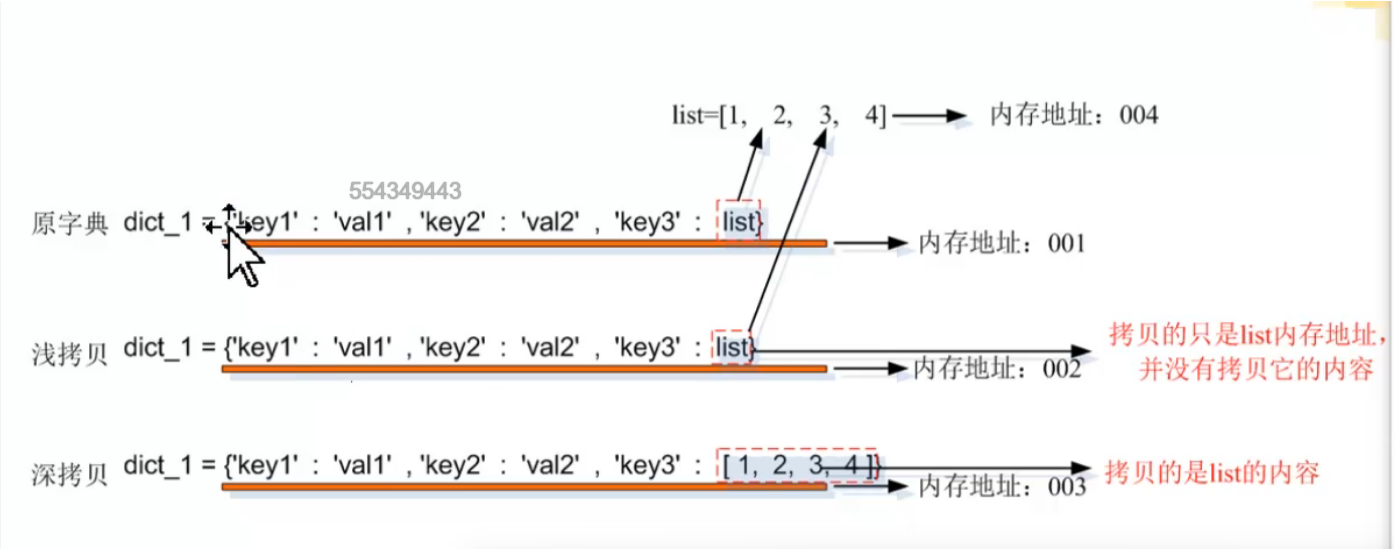一、定义
1、浅拷贝:拷贝父对象,引用子对象
2、深拷贝:拷贝父对象和子对象
3、深拷贝只在嵌套的容器对象内使用才有意义
二、其他定义
1、容器:把所有能存东西的对象都叫做容器
2、父对象:嵌套在外层的容器叫父对象
2、子对象:嵌套在内存的容器叫子对象
如:test_dict2 = {"key1":"value1","key2":[1,2,3,4,5]}
第一层字典是父对象,第二层列表是子对象
三、可变或不可变容器
1、str类型是不可变容器
如:box = "python"
2、列表是可变容器
如:test_list = [1,2,3]
3、字典是可变容器
如:test_dict = {"key1":"value1","key2":"value2"}
四、浅拷贝
1、语法:拷贝对象.copy()
2、例子
【例1】
test_dict1 = {"key1":"value1","key2":"value2"}
print(test_dict1)
结果:{'key1': 'value1', 'key2': 'value2'}
test_dict2 = test_dict1.copy()
print(test_dict2)
结果:{'key1': 'value1', 'key2': 'value2'}
现在修改test_dict1,看test_dict2会不会修改:
test_dict1["key2"] = "test2"
print(test_dict1)
print(test_dict2)
结果:
{'key1': 'value1', 'key2': 'test2'}
{'key1': 'value1', 'key2': 'value2'}
可见,test_dict2没有变
【例2】
test_dict1 = {"key1":"value1","key2":[1,2,3]}
#浅拷贝
test_dict2 = test_dict1.copy()
print(test_dict1)
print(test_dict2)
结果:
{'key1': 'value1', 'key2': [1, 2, 3]}
{'key1': 'value1', 'key2': [1, 2, 3]}
现在,修改test_dict1:
test_dict1["key2"] .append("test")
print(test_dict1)
print(test_dict2)
结果:
{'key1': 'value1', 'key2': [1, 2, 3, 'test']}
{'key1': 'value1', 'key2': [1, 2, 3, 'test']}
可见test_dict1的子容器变了,test_dict2的子容器也变了
五、深拷贝
1、语法
import copy
copy.deepcopy(拷贝对象)
2、例子
test_dict1 = {"key1":"val1","key2":[1,2,3]}
test_dict2 = copy.deepcopy(test_dict1)
print(test_dict1)
print(test_dict2)
print(id(test_dict1))
print(id(test_dict2))
结果:
{'key1': 'value1', 'key2': [1, 2, 3]}
{'key1': 'value1', 'key2': [1, 2, 3]}
id:是两个值,说明不是同一内存
2912852694848
2912852767552
修改test_dict1:
test_dict1["key2"] .append("test")
print(test_dict1)
print(test_dict2)
结果:
{'key1': 'value1', 'key2': [1, 2, 3, 'test']}
{'key1': 'value1', 'key2': [1, 2, 3]}
可见test_dict2的子对象还是原来的值,说明深拷贝是拷贝子对象和父对象
六、深浅拷贝内存地址解析

欢迎来到testingpai.com!
注册 关于